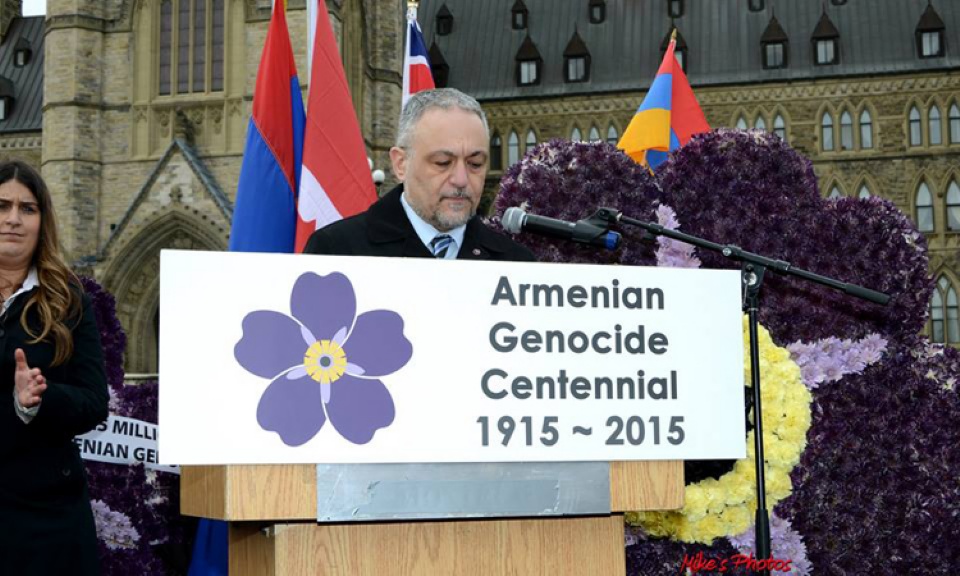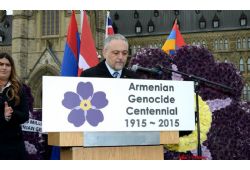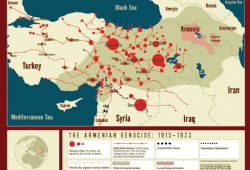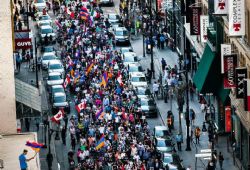2015 marked the 100th commemoration of the Armenian Genocide
committed by the Turks at the beginning of the 20th century.
Mheir Karakachian is Chairman of The Armenian Genocide Centennial Committee of
Canada (AGCCC) who for many years has been a volunteer advocate for this cause.
The AGCCC represents all Canadian-Armenian
institutions for Centennial commemorations/events and was founded in September
2012. Their mission is to commemorate the 100th anniversary throughout Canada.
They were divided into political, educational, religious, media, youth,
cultural and fundraising categories. The Committee implemented 40 plus projects
throughout Laval/Montreal to honor the 1.5 million victims massacred during the
Armenian Genocide. Another 60 projects were completed in other provinces. The
AGCCC joined forces with representatives of diverse cultures; the Rwandan,
Cambodian, Jewish, Pontian Greek, Assyrian and Ukrainian communities who also experienced
genocides to raise awareness about genocides, human rights and justice.
Mheir Karakachian is also responsible for
the Armenian Program taught at Sourp Hagop School in Montreal where he teaches
Armenian history/culture to secondary school students.
Mheir explained the AGCCC project, “100
objects for the Centennial” whereby Armenian families presented cherished items
passed to them by their survivor parents. Students of Sourp Hagop participated
in this project, too. One great-granddaughter presented a silver belt her grandmother
wore underneath her clothes for years. She smuggled it out of their burning
town in 1915 to use as a last resort ransom. The belt represented hope and
survival. Photos and diaries of survivors were presented by grandchildren/great-grandchildren.
On April 12, 2015, Pope Francis described
the mass killing of Armenians as genocide, a politically explosive
pronouncement that could have damaged the diplomatic relations of the Vatican
with Turkey. The Pontiff said it was his duty to honour the memories of those
massacred, adding that "concealing or denying evil is like allowing a
wound to keep bleeding without bandaging it." 1.5 million Armenians were
killed senselessly during the fall of the Ottoman Empire. Turkey still refuses
to accept that genocide occurred.
Genocide survivors in the Montreal region
include Knar Bohjelian-Yemenidjian, 106; Armenouhie Tenkerian-Piliguian, 102;
and Keghetzik Hagopian-Zourikian 104
The intense period of the Armenian
genocide occurred between 1915 and 1917. Within the Ottoman Empire, the Armenian
population in the six Armenian provinces (Eastern Turkey) was 2,000,000 in
1915. Armenia was divided between the
Russian, Ottoman and Persian empires. Western Armenia was part of the Ottoman
Empire and included up to 2.5 million Armenians.
One of the main reasons for the genocide is
that for centuries after the Ottoman Turk invasion, Armenians were treated as third
class citizens and sometimes as sub-humans. In the six Armenian provinces, they
were treated as serfs or slaves and were called gyavours, a derogatory, remark that means “infidels” and (still
used in Turkey). In the late 19th century, Armenians demanded to be
treated equally. Basic reforms were known as the Armenian Question. Sultan
Abdul Hamid, monarch of the Ottoman Empire, responded to these demands by
unleashing the 1895-96 massacres of Armenians. 300,000 innocent lives were lost.
The Western powers dubbed Abdul Hamid as the Red Sultan, but did not do much to
resolve the Armenian Question. The Turks took the opportunity during the First
World War to eradicate the Armenian Question. 100,000 Armenian soldiers were
drafted into the Ottoman army in 1914 once Turkey declared war on Russia.
During the first phase of this massacre,
Armenian soldiers in the Ottoman army were disarmed and reformed to dig
trenches, provide hard labor, and thus, were not trusted to own a gun. Exhausted soldiers were killed and their
bodies left in trenches they had built. After depriving Armenians of
self-defence, the second blow left Armenians leaderless. On April 24th,
1915, 600 plus Armenian leaders were sent to exile and imprisoned. They wanted
to eradicate leaders; therefore, they were killed by assigned bandits with
daggers while being transported. The third phase was forced deportation of
women, children and elderly who believed they were being taken to a safer destination,
but in reality they were taken to the Ottoman province of Aleppo. On their way
through the Syrian deserts, people in these “death caravans” died of
starvation, sickness, exhaustion or at the hands of Turkish gendarmes who accompanied
them. Women and girls were raped or abducted. Children were sold to Turks or
Kurdish tribesmen to be forcibly Islamised or Turkified.
The Turkish government released murderers
from jail to create death squads called Teshkilati
mahsousa who were responsible for attacking and slaughtering caravans of
people who crossed the desert. After death marches, only 5<>percentage<> reached Aleppo. They
survived because of Celal Bey, Governor of Aleppo, who resisted carrying out
orders of the Turkish government to annihilate them.
Between 1915 and 1918, 300,000 surviving refugees
who crossed to the Russian side of Armenia, gathered around the cathedral of Ejmiadzin,
the holiest site for Armenians. In their makeshift tents, many died from
typhus, malaria or starvation. In 1918, there were few Armenians left in
Western Armenia. Those saved by fate adopted Turkish names and denied their
true identity. A final wave of atrocities hit the Armenians in 1922. Massacres befell
the city of Smyrna (Izmir,Turkey) and Pontian Greek regions. Smyrna, inhabited
by Greeks and Armenians paid the price of the Greek-Turkish war and was burned
down. A Canadian nurse and heroine, Sarah Corning saved the lives of 5000
Armenian orphans from the fires of Smyrna.
Fifty years post-war, Armenians rarely spoke
about the genocide. It was as if a ‘dark cloud’ hung in every Armenian
household. Each year on April 24, the Medz
Yeghern (the Great Murder) was commemorated in churches. In 1965, the second
generation of Armenians revolted against this silent mourning and asked
questions about their lost homeland and the horrendous fate that befell their
grandparents. They sought justice to ensure the Armenian Genocide would be recognized
worldwide.
During the 50 years after the 1965
awakening, Armenians demanded justice and countered the utter denial that Turkish
governments put forth to cast doubt about the Armenian Genocide. Efforts resulted in securing recognition of
the Armenian Genocide by 28 countries, including Canada. They also cracked the
wall of censorship within Turkey and made members of the Turkish civil society
and others raise questions, ask for forgiveness and call it genocide.
In 2015, the international community was
aware of the truth, despite continuous fabrications by Turkish officials. From the
2004 recognition by the Canadian Parliament to the 2007 declaration of International
Association of Genocide Scholars and unequivocal recent message of Pope Francis,
annihilation of Armenians in 1915, once called the “the Forgotten Genocide”, is
an established fact that demands just restitution and closure.
2015 was an important turning point in Armenian
history. The torch has been passed to the new generation who are living proof
of the rebirth of Armenians and are the response to a failed annihilation
attempt. They must keep their Armenian heritage, identity/culture alive and raise
Genocide awareness to avoid repeating history. They are convinced that silence
and indifference may have lethal consequences; an unpunished crime that spawned
new genocides from the Holocaust to Cambodia, Rwanda and Sudan.
The 100-year anniversary is not an end but
a beginning, allowing Armenians to celebrate their continuing life as a surviving
nation and to demonstrate their resilience. Truth has finally prevailed.
More info;
http;//www.genocide-museum.am/eng/index.php
http;//armeniangenocide100.org/en
http;//www.genocidescholars.org
www.genocidecentennial.ca
Facebook; Armenian Genocide Centennial Committee
of Canada
Photos by Mike Tashjian - commemoration of the Centennial of the Armenian Genocide 2015(1)
@2004 Armenian National Committee of America

- La fin d'une époque :
- Un Adieu Émouvant
- Le nouveau Complexe aqua...
Articles
Calendar
Virtual- ANNUAL TEACHER APPRECIATION CONTEST
- APPUI LAVAL
- ARTS & CULTURE
- CAMPS
- CAR GUIDE
- CCIL
- CENTENNIAL ACADEMY
- CHARITY FUNDRAISING
- CITYTV
- COSMODÔME
- COMMUNITY CONNECTIONS
- COVER STORY
- DINA DIMITRATOS
- ÉCOLE SUPÉRIEURE DE BALLET DU QUÉBEC
- EDITORIALS
- ÉDUCALOI
- EDUCATION
- EMPLOYMENT & ENTREPRENEURSHIP
- FÊTE DE LA FAMILLE
- FÊTE DU QUARTIER SAINT-BRUNO
- FAMILIES
- FESTIVAL LAVAL LAUGHS
- FÊTE DE QUARTIER VAL-DES-BRISES
- FINANCES
- GLI CUMBARE
- GROUPE RENO-EXPERT
- HEALTH & WELL-BEING
- 30 MINUTE HIT
- ANXIETY
- CHILDREN`S HEALTH & WELLNESS
- CLOSE AID
- DENTAL WELLNESS
- EXTREME EVOLUTION SPORTS CENTRE
- FONDATION CITÉ DE LA SANTÉ
- GENERAL
- HEARING HEALTH
- MESSAGES FROM THE HEALTH AGENCY OF CANADA
- MENTAL HEALTH
- SEXUALITY
- SOCIAL INTEGRATION
- SPECIAL NEEDS
- TEENS
- THE NUTRITION CORNER
- THE NUTRITION CORNER - RECIPES
- VACATION DESTINATION
- WOMEN'S FITNESS
- WOMEN'S HEALTH
- HILTON MONTREAL/LAVAL
- HOME & GARDEN
- INTERNATIONAL WOMEN'S DAY
- JAGUAR LAVAL
- LAVAL À VÉLO
- LAVAL FAMILIES TV SHOW
- LAVAL FAMILIES MAGAZINE CARES
- LAVAL URBAN IN NATURE
- LE PARCOURS DES HÉROS
- LES PETITS GOURMETS DANS MA COUR
- LEON'S FURNITURE
- LEONARDO DA VINCI CENTRE
- LFM PREMIERES
- LIFE BALANCE
- M.P. PROFILE
- MISS EDGAR'S AND MISS CRAMP'S SCHOOL
- MISSING CHILDREN'S NETWORK
- NETFOLIE
- NORTH STAR ACADEMY LAVAL
- OUTFRONT MEDIA
- PASSION SOCCER
- PARC DE LA RIVIÈRE-DES-MILLE-ÎLES
- PÂTISSERIE ST-MARTIN
- PIZZERIA LÌOLÀ
- PLACE BELL
- PORTRAITS OF YOUR MNA'S
- ROCKET DE LAVAL
- SACRED HEART SCHOOL
- SCOTIA BANK
- SHERATON LAVAL HOTEL
- SOCIÉTÉ ALZHEIMER LAVAL
- STATION 55
- STL
- SUBARU DE LAVAL
- TECHNOLOGY
- TEDXLAVAL
- TODAY`S LAURENTIANS AND LANAUDIÈRE
- TODAY`S LAVAL
- WARNER MUSIC
- THIS ISSUE
- MOST RECENT
Magazine
Remembrance of the Armenian Genocide
Articles ~e 105,7 Rythme FM 4 chemins Annual Teacher Appreciation Contest Appui Laval Arts & Culture Ballet Eddy Toussaint Camps THIS ISSUE MORE...
CONTESTS Enter our contests
CONTESTS Enter our contests
CALENDAR
Events & Activities
COMMUNITY Posts Events
PUBLICATIONS Our Magazine Family Resource Directory
LFM BUSINESS NETWORK Learn more
COUPONS Click to save!
COMMUNITY Posts Events
PUBLICATIONS Our Magazine Family Resource Directory
LFM BUSINESS NETWORK Learn more
COUPONS Click to save!
SUBSCRIPTIONS
Subscribe to the magazine
Un-Subscribe
E-NEWSLETTER Subscribe to our E-newsletter Un-Subscribe
WRITE FOR US Guidelines & Submissions
POLLS Vote today!
E-NEWSLETTER Subscribe to our E-newsletter Un-Subscribe
WRITE FOR US Guidelines & Submissions
POLLS Vote today!
ADVERTISERS
How to & Media guide
Pay your LFM invoice
SUGGESTIONS Reader's Survey Suggest a Listing
LFM About Us Our Mission Giving Back Contact Us
SUGGESTIONS Reader's Survey Suggest a Listing
LFM About Us Our Mission Giving Back Contact Us
 PICK-UP LOCATIONS
Get a copy of LFM!
PICK-UP LOCATIONS
Get a copy of LFM!
TERMS & CONDITIONS Privacy | Terms
ISSN (ONLINE) 2291-1677
ISSN (PRINT) 2291-1677
Website by ZENxDESIGN






 BY:
BY: 
Tweet
Share